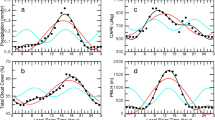Abstract
The role of cloud cover in determining the sensitivity of climate has been a source of great uncertainty. This article reviews the distributions of cloud cover change from several climate sensitivity experiments conducted at the Geophysical Fluid Dynamics Laboratory of NOAA (GFDL) and other institutions. Two of the sensitivity experiments conducted at GFDL used a general circulation model with a limited computational domain and idealized geography, whereas three other experiments were conducted by the use of a global model with realistic geography. A thermal forcing imposed was either a change of solar constant or that of the CO2-concentration in the atmosphere. It was found that in all five cases, clouds were decreased in the moist, convectively active regions such as the tropical and middle latitude rainbelts, whereas they increased in the stable region near the model surface from middle to higher latitudes. In addition, cloud also increased in the lower model stratosphere and generally decreased in the middle and upper troposphere for practically all latitudes.
A comparison of the cloud changes obtained from investigations carried out at other institutions reveals certain qualitative (but not necessarily quantitative) similarities to the GFDL results. These similarities include a general reduction of tropospheric cloud cover especially in the vicinity of the rainbelts, a general increase of lower stratospheric cloud cover for almost all latitudes and an increase of low stratiform cloud in high latitudes.
Similar content being viewed by others
References
Cess, R. D.: 1976, ‘Climate Change: An Appraisal of Atmospheric Feedback Mechanisms Employing Zonal Climatology’, J. Atmos. Sci. 33, 1831–1843.
Hansen, J., Lacis, A., Rind, D., Russel, G., Stone, P., Fung, I., Ruedy, R., and Lerner, J.: 1984, ‘Climate Sensitivity: Analysis of Feedback Mechanisms’, Climate Processes and Climate Sensitivity, Geophysical Monograph, 29, Maurice Ewing Vol. 5, American Geophysical Union, Washington, D.C., 130–163.
Hartmann, D. L. and Short, D. A.: 1980, ‘On the Use of Earth Radiation Budget Statistics for Studies of Clouds and Climate’, J. Atmos. Sci. 37, 1233–250.
London, J.: 1957, ‘A Study of the Atmospheric Heat Balance’, Final Report, AFCRC Contract No. AF 19(122)-165, New York University, 99 pp. DDC AD 117227.
Manabe, S. and Wetherald, R. T.: 1967, ‘Thermal Equilibrium of the Atmosphere with a Given Distribution of Relative Humidity’, J. Atmos. Sci. 24, 241–259.
Manabe, S. and Wetherald, R. T.: 1975, ‘The Effects of Doubling CO2 Concentration on the Climate of a General Circulation Model’, J. Atmos. Sci. 32, 3–15.
Manabe, S. and Wetherald, R. T.: 1980, ‘On the Distribution of Climate Change Resulting from an Increase in CO2 Content of the Atmosphere’, J. Atmos. Sci. 37, 99–118.
Manabe, S., and Wetherald, R. T.: 1982, ‘Simulation of Global Cloud Cover’, World Climate Program Report No. 34, World Meteorological Organization, Geneva.
Manabe, S., Smagorinsky, J., and Strickler, R. F.; 1965, ‘Simulated Climatology of a General Circulation Model with a Hydrologic Cycle’, Mon. Wea. Rev. 93, 769–798.
Manabe, S. and Stouffer, R. J.: 1980, ‘Sensitivity of a Global Model to an Increase of CO2 -concentration in the Atmosphere’, J. Geophys. Res. 85 (C-10), 5529–5554.
Ohring, G. and Clapp, P. F.: 1980, ‘The Effect of Changes in Cloud Amount on the Net Radiation at the Top of the Atmosphere’, J. Atmos. Sci. 37, 447–454.
Roads, J. O.: 1978, ‘Numerical Experiments on the Sensitivity of an Atmospheric Hydrologic Cycle to the Equilibrium Temperature’, J. Atmos. Sci. 35, 753–773.
Schneider, S. H.: 1972, ‘Cloudiness as a Global Climate Feedback Mechanism: The Effects on the Radiation Balance and Surface Temperature of Variations in Cloudiness’, J. Atmos. Sci. 29, 1413–1422.
Schneider, S. H., Washington, W. M., and Chervin, R. M.: 1978, ‘Cloudiness as a Climate Feedback Mechanism: Effects on Cloud Amounts of Prescribed Global and Regional Surface Temperature Changes in the NCAR GCM’, J. Atmos. Sci. 35, 2207–2221.
Somerville, R. C. and Remer, L. A.: 1984, ‘Cloud Optical Thickness Feedbacks in the CO2 Climate Problem’, J. Geophys. Res. 89, No. D6, 9668–9672.
Washington, W. M. and Meehl, J.: 1984, ‘Seasonal Cycle Experiments on the Climate Sensitivity Due to a Doubling of CO2 with an Atmospheric General Circulation Model Coupled to a Simple Mixed Layer Ocean Model’, J. Geophys. Res. 89, 9475–9503.
Wetherald, R. T. and Manabe, S.: 1975, ‘The Effects of Changing the Solar Constant on the Climate of a General Circulation Model’, J. Atmos. Sci. 32, 2044–2059.
Wetherald, R. T. and Manabe, S.: 1980, ‘Cloud Cover and Climate Sensitivity’, J. Atmos. Sci. 37, 1485–1510.
Author information
Authors and Affiliations
Rights and permissions
About this article
Cite this article
Wetherald, R.T., Manabe, S. An investigation of cloud cover change in response to thermal forcing. Climatic Change 8, 5–23 (1986). https://doi.org/10.1007/BF00158967
Received:
Revised:
Issue Date:
DOI: https://doi.org/10.1007/BF00158967




